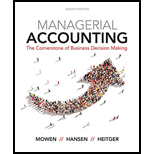
1.
Compute the minimum transfer price and maximum transfer price.
1.
Answer to Problem 46P
The minimum and maximum transfer price will be $26 and $31 respectively.
Explanation of Solution
Transfer Price:
The amount of price charged by the selling department for a component to the purchasing department of a similar company is known as transfer price.
The maximum transfer price will be $31 per unit because the subwoofers can be sold at this price to the customers. Use the following formula to calculate the minimum transfer price:
Substitute $31 for maximum transfer price and $5 for selling and distribution cost in the above formula.
Therefore, the minimum transfer price will be $26 per unit.
2.
Calculate the transfer price that can be negotiated. Also, calculate the markup that can be applied to this transfer price.
2.
Answer to Problem 46P
The transfer price that can be negotiated is $28.5 per unit. The markup percentage is 0.425 or 42.5%.
Explanation of Solution
Use the following formula to calculate the transfer price that can be negotiated:
Substitute $26 for a minimum transfer price and $31 for a maximum transfer price in the above formula.
Therefore, the transfer price that can be negotiated is $28.5 per unit.
Use the following formula to calculate the markup percentage:
Substitute $28.50 for a minimum transfer price and $20 for maximum transfer price in the above formula.
Therefore, the markup percentage is 0.425 or 42.5%.
3.
Calculate the new full cost-plus transfer price.
3.
Answer to Problem 46P
The full cost-plus transfer price is $43.51 per unit.
Explanation of Solution
Use the following formula to calculate the new full cost-plus transfer price:
Substitute $29.50 for negotiated transfer price and 47.5% for markup percentage in the above formula.
Therefore, the full cost-plus transfer price is $43.51 per unit.
Working Notes:
1. Calculate the minimum transfer price in order to calculate the negotiated transfer price:
The minimum transfer price is $27 per unit.
Calculation of negotiated transfer price:
Hence, the negotiated transfer price is $29.50 per unit.
2. Calculation of markup percentage:
Hence, the markup percentage is 0.475 or 47.5%.
4.
Describe whether the divisions would renegotiate on the full cost-plus pricing arrangements.
4.
Explanation of Solution
As the markup percentage is too high, the divisions would re-negotiate the transfer prices. This is because the purchasing division would desire to purchase the part at lower prices or may purchase from another supplier if the selling division does not provide the appropriate price. The Component division has to decrease the per unit price of the part.
Want to see more full solutions like this?
Chapter 11 Solutions
Managerial Accounting: The Cornerstone of Business Decision-Making
- I need help solving this general accounting question with the proper methodology.arrow_forwardCan you solve this general accounting problem using appropriate accounting principles?arrow_forwardPlease provide the correct answer to this general accounting problem using valid calculations.arrow_forward
- Stockholders' equity at the end of the year was ____.arrow_forwardI need the correct answer to this general accounting problem using the standard accounting approach.arrow_forwardThe installation of a ______ system will create confidence in the minds of public about the fairness of the prices charged. a. Costing b. Financial accounting c. Management accounting d. Informationarrow_forward
- Principles of Accounting Volume 2AccountingISBN:9781947172609Author:OpenStaxPublisher:OpenStax College
 Managerial AccountingAccountingISBN:9781337912020Author:Carl Warren, Ph.d. Cma William B. TaylerPublisher:South-Western College Pub
Managerial AccountingAccountingISBN:9781337912020Author:Carl Warren, Ph.d. Cma William B. TaylerPublisher:South-Western College Pub Cornerstones of Cost Management (Cornerstones Ser...AccountingISBN:9781305970663Author:Don R. Hansen, Maryanne M. MowenPublisher:Cengage Learning
Cornerstones of Cost Management (Cornerstones Ser...AccountingISBN:9781305970663Author:Don R. Hansen, Maryanne M. MowenPublisher:Cengage Learning  Managerial Accounting: The Cornerstone of Busines...AccountingISBN:9781337115773Author:Maryanne M. Mowen, Don R. Hansen, Dan L. HeitgerPublisher:Cengage Learning
Managerial Accounting: The Cornerstone of Busines...AccountingISBN:9781337115773Author:Maryanne M. Mowen, Don R. Hansen, Dan L. HeitgerPublisher:Cengage Learning Financial And Managerial AccountingAccountingISBN:9781337902663Author:WARREN, Carl S.Publisher:Cengage Learning,
Financial And Managerial AccountingAccountingISBN:9781337902663Author:WARREN, Carl S.Publisher:Cengage Learning,




